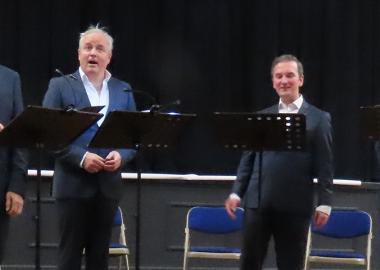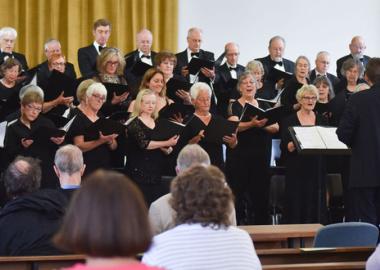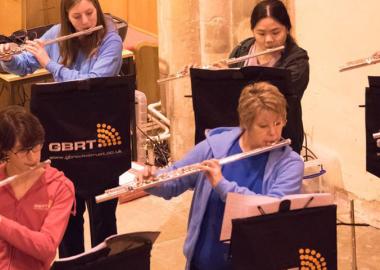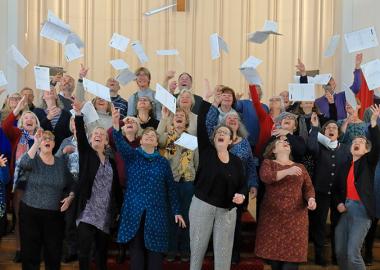In celebration of Women’s History Month, Making Music spotlights six iconic female composers of colour, a demographic that very often gets underrepresented in the music industry.
Global majority composers continue to be underrepresented within the music industry. Female composers in particular have historically been overlooked, even more so than their male counterparts. In a past blog, Barbara Eifler (Chief Executive of Making Music) discussed Donne, Women in Music’s annual report, which shockingly revealed that only 7.7% of programmed works were composed by women, of which 5.5% were white women.
So how can we address this imbalance? And what are some great examples of female composers of colour?
If you’re considering diversifying your repertoire and are in need of inspiration, the Making Music staff recommend these excellent female composers of colour.
Nubiya Garcia
Nubiya Garcia is a British jazz saxophonist, bandleader, and composer. Nubiya is one of the most notable UK jazz musicians of today’s generation. Nubiya is of Guyanese and Trinidadian descent and her works are heavily influenced by her mixed heritage and beautifully intertwine multiple genres including reggae, club, calypso, soca and cumbia.
Nubiya grew a strong interest in playing music from the age of 5, learning the saxophone at 10 and went on to study music at Trinity Laban Conservatoire of Music and Dance. Since then, Nubiya has had many career highlights, including releasing two EPs and a solo performance at BBC Proms in 2021.
Her most recent album titled Source, released in August 2020, has received wide critical acclaim, and was also shortlisted for the Hyundai Mercury Prize. Watch her Tiny Desk debut featuring tracks ‘Source, Pace and Boundless Beings’ from the album.
Anoushka Shankar
Anoushka Shankar is a British-American sitar player and composer. Anoushka began training as a sitar player at age 8 under her father, Ravi Shankar, who was an acclaimed Indian sitar maestro. She debuted on stage at the early age of 13, performing alongside tabla maestro Zakir Hassan. Anoushka continued to perform on stage with her father and was signed by a major record label at the age of 16, and at 18 decided to pursue a solo musical career.
Anoushka’s work draws influences from many genres including Indian classical music, contemporary and electronic music. Anoushka is the first and youngest woman to ever receive a British House of Commons Shield, seven Grammy nominations, and the first woman of Indian heritage to present at the Grammys and her works have also been included in the UK A-Level syllabus.
Listen to a live performance of ‘Voices of the Moon’ from her album Rise (released in 2005).
Shiva Feshareki
Shiva Feshareki is a British-Iranian experimental composer, turntablist, and DJ. Shiva notes that her influences includes the late 20th century ‘avante garde electronic music and electronic dance music’. Shiva is credited for exploring unusual sounds, sampling pieces to create otherworldly soundscapes, and producing electronic compositions.
She received a doctorate in music composition from the Royal College of Music and is the recipient of the BBC Young Composer’s Award (2004), the Royal Philharmonic Society Composer’s Prize (2009) and the Ivor Novello Award for Innovation (2017).
Take a listen to Shiva’s album Turning world composed for BBC Proms (2021), with tracks like ‘Aetherworld’, a sombre number featuring the BBC singers and improvisation based on Still Point by Daphne Oram. The album is best listened to with headphones for an immersive experience.
Sona Jobarteh
Sona Jobarteh is a composer, singer, and multi-instrumentalist and comes from a long line of Griot* families in West Africa. The Gambian musician is an icon for breaking down generational boundaries by becoming the first professional female kora (West African harp) player to come out of the Griot tradition.
Sona learnt to play the kora as a young child and gave her first performance at the London Jazz Café and continued to perform on stage at a young age. She received an education in composition from the Purcell School of Music and later attended the Royal College of Music where she learnt to play an array of instruments including cello, harpsichord, and piano.
Her music is strongly influenced by her African and European heritage, which you can hear in works like ‘Innovation Through Preservation’.
*Griot is a West African historian, musician, poet, and/or storyteller.
Florence Price
Florence Price, 1887-1953, was an American classical composer, pianist, organist, and music teacher. Considered a pioneering composer, Florence was educated at the New England Conservatory of Music where she received a diploma in both piano and the organ. In the earlier years of her musical career, Florence worked as a piano teacher, an organist for silent film screenings, and composed songs for radio ads as she struggled to make a breakthrough in segregated America.
Her journey as a composer took full stride when she entered and won several awards including the Wanamaker Music Composition Contest for her 'First Symphony'. This was a huge milestone in her career. It was the first time a symphony, composed by an African-American woman, was performed by a major US orchestra (1933).
Over the span of her career, Florence produced over 300 compositions including four symphonies, four concertos and choral works.
Queen Liliʻuokalani
Queen Liliʻuokalani, 1838-1917, ruled as queen of the Hawaiian Kingdoms and was one of the last monarchs of the islands. She was a trained vocalist and one of the most accomplished composers from Hawiʻi to date, leaving behind a lasting legacy. She was also an organist and a choir director.
During the span of her life, Queen Liliʻuokalani composed over 150 meles (songs and chants), the most famous being ‘Aloha ‘Oe’ which translates to ‘Farewell to Thee’ written about two lovers bidding goodbye. The song later became a significant symbol of mourning for the lives lost during the Hawaiian independence.
Queen Liliʻuokalani also composed Hawaiʻi’s national anthem ‘He Mele Lāhui Hawaiʻi’ (the third out of four Hawaiian national anthems), a piece written for Queen Victoria’s Jubilee, and even as a political prisoner with no access to musical instruments or the outside world, she composed ‘Kuʻu Pua I Paoakalani’ and ‘Ke Aloha o ka Haku’.
Lili’uokalani’s compositions have been published in The Queen’s Songbook.
Discover more female composers of colour:
- Guest blog: A deeper look at female classical composers of colour by Elizabeth de Brito, musicologist and host of the Daffodil Perspective podcast
- Repertoire and programme notes available via Making Music’s Music bank – filter composers by nationality
- The Big List by Donne’s Women in Music featuring more than 5,000 female composers
- Directory of living black composers from Music by Black Composers
- Theodore Front Musical Literature features subcategories of music by women, black composers, Asian and Asian-American composers, and Latin and Latin-American composers
- UCLA Library provides resources and guidance on finding works by musicians and composers of colour
- Scores by composers of colour
- Female composers sorted by time period via the Oxford Music website
- I Can Compose offers a calendar of female composers for Women’s History Month – download for free
The Making Music staff have curated a playlist of female composers of colour and musicians which you can listen to on Spotify and Youtube










